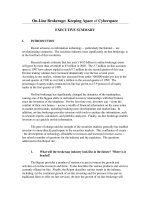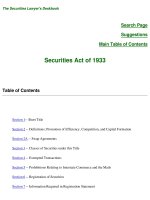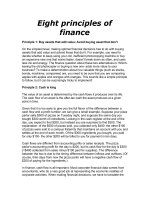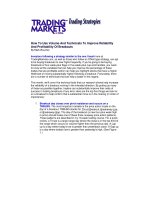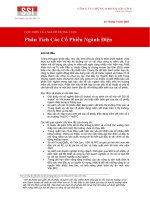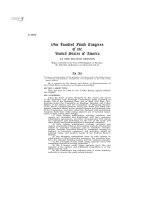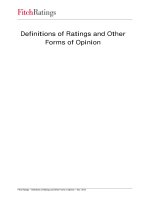Winter Semester 2010 Lahore School of Economics pdf
Bạn đang xem bản rút gọn của tài liệu. Xem và tải ngay bản đầy đủ của tài liệu tại đây (971.36 KB, 101 trang )
Learning Objectives
Common Stock Valuation
Dividend Growth model
Zero Growth
Constant Growth
Multiple growth model
Intrinsic Value & Market price
Relative Valuation Techniques (P/E,P/S,P/S)
Components of Required Return
Fixed Income (Bonds)
Treasuries
Corporates
Equities
Preferred Stock
Common Stock
It is an equity ownership in a corporation, initially
issued to raise capital
Points to keep in mind!
C/F’s are NOT known in advance
Life of stocks is forever – no maturity
Difficult to observe required rate of return for
discounting
The two approaches to valuing common stock using
fundamental security analysis are:
1. Discounted Cash flow techniques
2. Relative valuation techniques
The two approaches to valuing common stocks using
fundamental security analysis are:
1. Discounted Cash flow techniques
Attempts to estimate the value of a stock today using a
present value analysis.
2. Relative valuation techniques
A stock is valued relative to other stocks based on the
basis of ratios.
Key difference!
!"
#$
The estimated value of a security is equal to the
discounted value (Present Value) of the future stream of
cash flows that an investor expects to receive from the
security:
Estimated Value of any security = V
0
V
0
= Expected Cash Flows/ (1 + K)
t
Where:
K is the appropriated Discount Rate
!"
#$
To use Discounted Cash flow Model, an investor must:
1. Estimate the amount & timing of future stream of Cash
flows.
2. Estimate an appropriate Discount Rate
3. Use these two components in PV Model to estimate the
value of the security, which is then compared to the
current Market Price of the security.
!"
#$
Two different approaches to the cash flows & discount
rates can be used in the valuation of stocks:
1. Value the Equity of the Firm, using the required rate of
Return to shareholders.
2. Value the entire firm using the Weighted Average Cost
of Capital (WACC).
!"#$
How to come up with the Price of a Stock?
Assumptions:
Assume a dividend the stock will pay.
Assume a selling price at the end of 1 year.
Come up with a required rate of return.
!"#$
%&
Example:
Stock selling price after 1 year is $70
Stock dividend will be $10
Investors require 25% return
PV = 80/(1.25)
= $64
!"#$
%&
Example:
Stock selling price after 1 year is $70
Stock dividend will be $10
Investors require 25% return
PV = 80/(1.25)
= $64
Or,
Po = (D
1
+P
1
) / (1+k)
!"#$
P
1
at t
1
, could also be found the same way by
assuming year 2 price & dividend:
P
1
= (D
2
+P
2
) / (1+K)
!"#$
Substituting P
1
in P
o
equation:
P
o
= (D
1
+ (D
2
+P
2
)/(1+K)) / (1+K)
= [D
1
/(1+K)
1
] + [D
2
/(1+K)
2
] + [P
2
/(1+K)
2
]
Formula:
Po = E [D
n
/ (1+K)
n
]
Present Value of all future dividends as a
general valuation framework!
1. Investors must value a stream of dividends that may be
paid forever, since common stock has no maturity
value.
2. The dividend Stream is uncertain:
There is no specified number of dividends, if in fact
any are paid at all.
Dividends are Expected to grow in most cases.
'
Growth Rate Cases for the DDM:
The Zero Growth rate Case
The Constant Growth rate Case
The Multiple Growth rate Case
#()"*
Zero-growth:
A Dividend Stream resulting from Fixed dollar
Dividend equal to the current Dividend, D
o
.
So,
Value of the stock is a Present value of a Perpetuity!
P
o
= D/K
#()" %
&
A company pays a dividend of $2 per share, which is not
expected to change. Required return is 20%. What’s the
price per share today?
!"#$
'()"%&
A company pays a dividend of $2 per share, which is not
expected to change. Required return is 20%. What’s the
price per share today?
P
o
= D
o
/ k
= 2/0.2
= 10
#)"*
The constant Growth rate Case for the DDM reflects a
dividend stream that is expected to grow at a constant
rate g, forever.
Which implies:
If dividend just paid is D
o
, then the next D
1
is:
D
1
= D
o
*(1+g)
Dividend for period 2, D
2
:
D
2
= D
1
*(1+g)
= [D
o
*(1+g)] * (1+g)
= D
o
*(1+g)
2
#)"*
Stock Price with constant growth dividends:
P
o
= D
o
*(1+g) / (K-g)
OR
P
0
= D
1
/ (K – g)
%
+
Dividend paying stock
Required Return by investors is greater than the Growth
Rate of Dividends.
Dividends will grow at a constant Rate forever.
#)"* %
&
Suppose Do = 2.30, K=13%, g=5%. What’s the price per
share?
